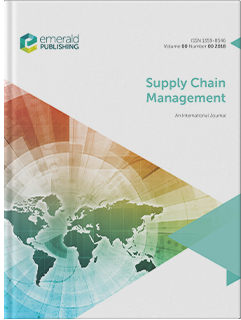Insight from industry: Moet Hennessy’s development of an innovative supplier diversity program in the wine and beverage industry
IF 8.4
3区 管理学
Q1 BUSINESS
Supply Chain Management: An International Journal
Pub Date : 2023-09-26
DOI:10.1108/scm-01-2023-0041
引用次数: 0
Abstract
Purpose Supplier diversity has roots in US supply chains going back 50 years. Unfortunately, supplier diversity programs have been hindered by less than wholehearted buyer adoption and stakeholder engagement. The original scoping of supplier diversity also holds limitations when comparing to the multidimensionality of the diversity and inclusion concept. The purpose of this article is to share lessons learned from the development of an innovative supplier diversity program by Moet Hennessy aimed at more sustainably scoping, scaling and stimulating supplier diversity programs. Design/methodology/approach The development and the design of Moet Hennessy’s supplier diversity program is presented. The design was informed, and partially supported by, a collaboration with the author. Critical reflections on pitfalls and outstanding questions are developed based upon the program design. Findings Moet Hennessy developed a supplier diversity program that is more comprehensively defined, targets a more global scale and includes innovative stakeholder engagement techniques such as the development of supplier diversity champions in the business. The program also is embedded in existing environmental social and governance initiatives. Originality/value Moet Hennessy’s supplier diversity program was not mandated by one of its customers but sourced from an academic collaboration and stimulated by competitive opportunity. The program was designed bottoms up, not top down. The program is sponsored outside of procurement and has champions throughout the business. The program expands beyond the traditional scoping of supplier diversity programs. Pathways and pitfalls for managers are identified based upon insights from Moet Hennessy’s experience. These inform suggestions for further research.行业洞察:酩悦轩尼诗在葡萄酒和饮料行业发展创新的供应商多元化计划
供应商多样性在美国供应链中已有50年的历史。不幸的是,供应商多元化计划受到了不那么全心全意的买家采纳和利益相关者参与的阻碍。与多元化和包容性概念的多维性相比,供应商多样性的原始范围也存在局限性。本文的目的是分享酩悦轩尼诗创新供应商多元化计划的发展经验,该计划旨在更可持续地确定供应商多元化计划的范围、规模和激励。介绍了酩悦轩尼诗供应商多元化计划的发展和设计。该设计是由与作者的合作提供的,并得到了部分支持。在程序设计的基础上,对陷阱和突出问题进行批判性反思。酩悦轩尼诗开发了一个定义更全面的供应商多样性计划,目标更全球化,包括创新的利益相关者参与技术,如在企业中发展供应商多样性冠军。该计划还嵌入到现有的环境、社会和治理倡议中。创意/价值酩悦轩尼诗的供应商多元化计划并非由某个客户强制执行,而是源于学术合作,并受到竞争机会的推动。这个项目是由下而上而不是由上而下设计的。该项目在采购部门之外得到赞助,在整个企业中都有支持者。该计划超出了供应商多元化计划的传统范围。根据酩悦轩尼诗的经验,确定了管理人员的途径和陷阱。这些为进一步研究提供了建议。
本文章由计算机程序翻译,如有差异,请以英文原文为准。
求助全文
约1分钟内获得全文
求助全文
来源期刊
CiteScore
16.70
自引率
5.70%
发文量
27
期刊介绍:
Supply Chain Management (SCM) is a journal that places great emphasis on research findings with international relevance and global impact, benefitting both theory and practice. To be considered for publication, research papers and case studies submitted to SCM must contribute to extending supply chain knowledge beyond a dyadic perspective.
The journal focuses specifically on empirical research and does not accept submissions related to modelling or simulation. This is because the challenges posed by globalization and rapidly evolving technology trends have a direct impact on supply chain design and management. Therefore, it is essential for contemporary supply chain practices to be responsive, proactive, integrated, and driven by information when managing the various components of the supply chain.

 求助内容:
求助内容: 应助结果提醒方式:
应助结果提醒方式:


